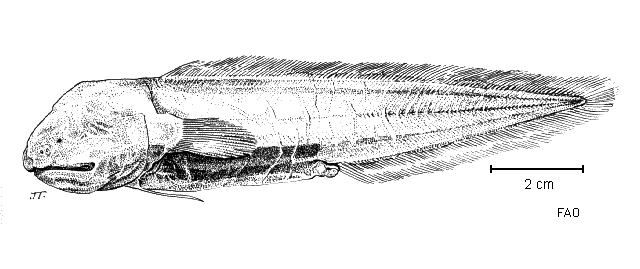| Bythitidae (Livebearing brotulas) |
| 15 cm SL (male/unsexed); 14.8 cm SL (female) |
|
bathydemersal; marine; depth range 625 - 2560 m |
| Indo-West Pacific: from off East Africa eastwards to Japan and New Zealand and in the Atlantic Ocean. |
|
Dorsal soft rays (total): 92-118; Anal soft rays: 61-78. This species is distinguished by the following characters: with joined vertical fins and loose, transparent, scaleless skin; body depth at origin of anal fin 13.0-16.5% SL; eyes are small or not externally visible; mouth almost horizontal; upper jaw ends well behind the eye; palatines edentate; jaws with small blunt or pointed teeth, no fangs; vomer with 3-7 fangs; anterior gill arch with 3-4 long rakers; D 92-118; A 61-78; pectoral fin 17-20 rays, with peduncle as long as or a little longer than high; pelvic fin with one ray; caudal fin rays 6-8; precaudal vertebrae 28-33, total vertebrae 77-87; vertebral centra in adults almost rectangular in lateral view; vertebrae generally poorly ossified; sagittal otolith rather large, oval and thin; penis partly covered ventrally by genital hood that ends in a medially placed clasper ventral to penis; no paired claspers in both sexes; fresh specimens with black peritoneum (Ref. 105129). |
| Found on or near bottom (Ref. 6527). The well-developed penis and reported presence of numerous spermatophores in histologically examined testes indicate internal fertilization. Eggs are found up 1 mm in diameter, but embryos were not observed (Ref. 105129). Uncommon species (Ref. 34024). |
|
Least Concern (LC); Date assessed: 10 July 2014 Ref. (130435)
|
| harmless |
Source and more info: www.fishbase.org. For personal, classroom, and other internal use only. Not for publication.

